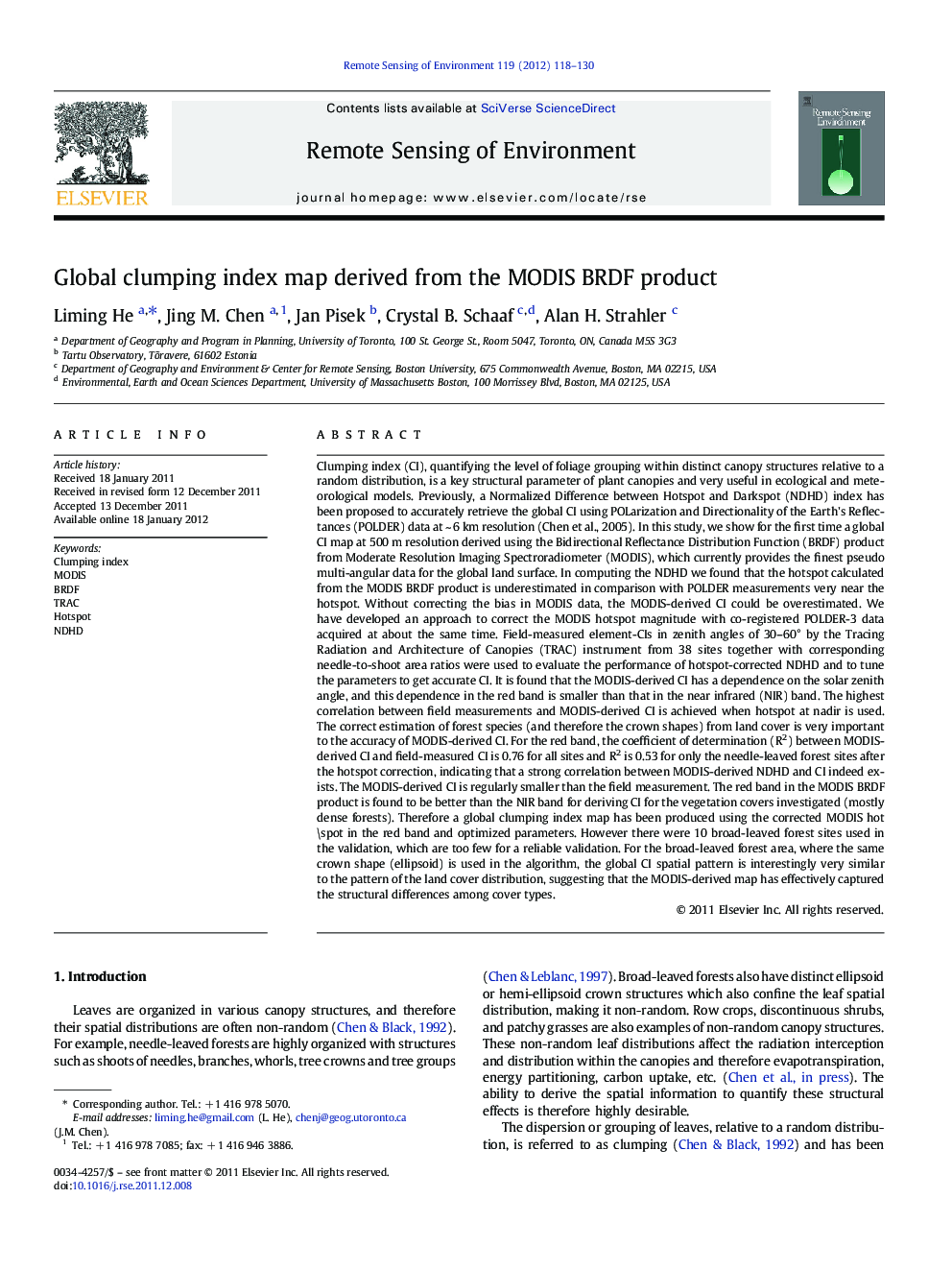| کد مقاله | کد نشریه | سال انتشار | مقاله انگلیسی | نسخه تمام متن |
|---|---|---|---|---|
| 4459204 | 1621281 | 2012 | 13 صفحه PDF | دانلود رایگان |

Clumping index (CI), quantifying the level of foliage grouping within distinct canopy structures relative to a random distribution, is a key structural parameter of plant canopies and very useful in ecological and meteorological models. Previously, a Normalized Difference between Hotspot and Darkspot (NDHD) index has been proposed to accurately retrieve the global CI using POLarization and Directionality of the Earth's Reflectances (POLDER) data at ~ 6 km resolution (Chen et al., 2005). In this study, we show for the first time a global CI map at 500 m resolution derived using the Bidirectional Reflectance Distribution Function (BRDF) product from Moderate Resolution Imaging Spectroradiometer (MODIS), which currently provides the finest pseudo multi-angular data for the global land surface. In computing the NDHD we found that the hotspot calculated from the MODIS BRDF product is underestimated in comparison with POLDER measurements very near the hotspot. Without correcting the bias in MODIS data, the MODIS-derived CI could be overestimated. We have developed an approach to correct the MODIS hotspot magnitude with co-registered POLDER-3 data acquired at about the same time. Field-measured element-CIs in zenith angles of 30–60° by the Tracing Radiation and Architecture of Canopies (TRAC) instrument from 38 sites together with corresponding needle-to-shoot area ratios were used to evaluate the performance of hotspot-corrected NDHD and to tune the parameters to get accurate CI. It is found that the MODIS-derived CI has a dependence on the solar zenith angle, and this dependence in the red band is smaller than that in the near infrared (NIR) band. The highest correlation between field measurements and MODIS-derived CI is achieved when hotspot at nadir is used. The correct estimation of forest species (and therefore the crown shapes) from land cover is very important to the accuracy of MODIS-derived CI. For the red band, the coefficient of determination (R2) between MODIS-derived CI and field-measured CI is 0.76 for all sites and R2 is 0.53 for only the needle-leaved forest sites after the hotspot correction, indicating that a strong correlation between MODIS-derived NDHD and CI indeed exists. The MODIS-derived CI is regularly smaller than the field measurement. The red band in the MODIS BRDF product is found to be better than the NIR band for deriving CI for the vegetation covers investigated (mostly dense forests). Therefore a global clumping index map has been produced using the corrected MODIS hot\spot in the red band and optimized parameters. However there were 10 broad-leaved forest sites used in the validation, which are too few for a reliable validation. For the broad-leaved forest area, where the same crown shape (ellipsoid) is used in the algorithm, the global CI spatial pattern is interestingly very similar to the pattern of the land cover distribution, suggesting that the MODIS-derived map has effectively captured the structural differences among cover types.
► MODIS hotspot is corrected by POLDER-3 hotspot.
► The global clumping index map is derived at 500 m resolution.
► The clumping index map is validated by 38 TRAC ground measurements.
Journal: Remote Sensing of Environment - Volume 119, 16 April 2012, Pages 118–130